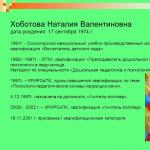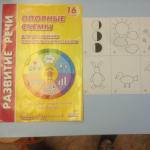Speech development project for children of the middle group "Children and fairy tales
Larisa Baltina
I bring to your attention a long-term project on the development of speech using mnemotables.
Everyone knows how to speak confusedly,
few speak clearly.
Galileo Galice.
Introduction
Speech is a form of communication that has developed in the process of human historical evolution and is mediated by language. Speech arises as a necessary and sufficient means for solving those problems of communication that confront the child at a certain stage of his development.
Every child in kindergarten needs to be taught how to express their thoughts correctly. The speech of children should be lively, direct, expressive. The coherence of speech is the coherence of thoughts, which reflects the logic of the child's thinking, his ability to comprehend what is perceived and express it in coherent speech.
In the practice of my work, I use various methods and techniques for the development of speech. This is an artistic word, questions, a conversation, a story, drawing up a plan, re-reading with an agreement, didactic games, etc. But all of the above was not enough to solve the problem. Having studied the literature, I came to the conclusion that mnemonics can help me in solving the problem of developing coherent speech in preschool children.
Relevance
The study of the problem of the development of coherent speech is due to the fact that in the activities of people there is no such area where speech would not be used, it is needed everywhere, and especially at the stage of learning. The success of learning depends on the quality of speech. With the help of speech, communication, the child easily and imperceptibly enters the world around him, learns a lot of new, interesting things, can express his thoughts, desires, requirements. Speech is an activity in which people communicate with each other through their native language. The development of coherent speech - the highest form of mental activity - determines the level of speech and mental development of the child (L. S. Vygotsky, A. A. Leontiev, S. L. Rubenshtein, F. A. Sokhin, etc.). It is in coherent speech that the main, communicative, function of speech is realized.
But, unfortunately, at present, speech disorders are increasingly observed in children, which drastically limit their communication with people around them. Figurative, rich in synonyms, additions and descriptions, speech in preschool children is a very rare phenomenon.
There are many problems in the speech of children:
Insufficient vocabulary and, as a result, the inability to make a common sentence;
Poor dialogical speech: inability to formulate a question correctly and in an accessible way, to build an answer;
Poor monologue speech: inability to compose a plot or descriptive story on the proposed topic, retell the text.
According to modern teachers and psychologists, the number of children with a low level of speech development is increasing every year. In view of the close relationship between speech and thinking, the development of evidence-based content and effective methods aimed at increasing the level of related speech development is of great importance and is a complex pedagogical problem.
Considering that at this time children are oversaturated with information, it is necessary that the learning process be interesting, entertaining, and developing for them.
There are factors that facilitate the process of becoming a coherent speech.
One of these factors, according to S. L. Rubinshtein, A. M. Leushina, L. V. Elkonin and others, is visibility. Examination of objects, pictures helps children name objects, their characteristic features, actions performed with them.
The second auxiliary factor is the creation of an utterance plan, the significance of which was repeatedly pointed out by the well-known psychologist L. S. Vygotsky. He noted the importance of sequential placement in the preliminary scheme of all the specific elements of the statement.
K. D. Ushinsky wrote: “Teach a child some five words unknown to him - he will suffer for a long time and in vain, but connect twenty such words with pictures, and he will learn on the fly.”
Mnemonics - translated from Greek - "the art of memorization." This is a system of methods and techniques that ensure the successful memorization, preservation and reproduction of information, knowledge about the features of natural objects, about the world around us, effective memorization of the structure of the story, and, of course, the development of speech.
I believe that if in the work of teaching children coherent speech to use the techniques of mnemonics, then this will help the child to be more sociable, his vocabulary will expand, the child will learn to speak coherently, tell, express his thoughts.
the main objective of my project: To create conditions for the development of cognitive and speech abilities in preschool children using mnemonics.
Project objectives:
Tutorials:
To create conditions for increasing the circle of children's knowledge about the world around them.
Exercise in the ability to dramatize small fairy tales.
Create conditions for the development of skills to memorize and retell small works using mnemonics techniques.
Developing:
Continue to develop the articulatory apparatus, work on diction, improve the distinct pronunciation of words and phrases, the intonational expressiveness of speech.
Develop self-reliance skills to overcome shyness, shyness, insecurity in children.
To continue work on the formation of interest in Russian folk tales.
Educational:
To cultivate a culture of speech, enrich and expand the vocabulary of children.
Working with parents:
Increasing the competence of parents on the issues of cognitive and speech development of children of middle preschool age.
Active involvement of parents in the educational process.
Project type: information - creative
Project type: long-term
Expected Result:
The interest of children in cognitive activity will increase, children will be willingly included in the educational process;
Increase: accuracy, coherence and expressiveness of speech;
Creativity develops;
The creative activity of children will increase: they will be happy to participate in the dramatization of fairy tales;
Children will watch theatrical performances of others with interest and will reproduce them with pleasure in their play activities;
Parents will be actively involved in the educational activities of the group, will be interested in developing technologies for working with children of preschool age.
Mnemonics develops not only coherent speech, but also contributes to the psychological emancipation of the child, eliminates the fear of speaking, develops courage and self-confidence.
Annotation to the project
For the development of cognitive and speech abilities, the project involves a variety of activities: gaming, motor, visual, musical, cognitive research. The work takes place throughout the entire educational process of finding a child in kindergarten. During the month, the content may change and be supplemented depending on the game situations.
Learning to retell literary works begins with familiar fairy tales: “Turnip”, “Gingerbread Man”, “Ryaba Hen”, while using the method of a joint story.
The scheme of teaching the retelling of a fairy tale:
1. Telling a fairy tale with a simultaneous display of a table theater.
2. Repeated story of the teacher with the children. The teacher starts the phrase, the children continue. For example, Once upon a time there was a grandfather (and a woman) They had a (pockmarked chicken) Children find subject pictures or me-squares with a color image of the heroes of a fairy tale on the table, lay them out in the correct sequence.
3. Showing illustrations, the teacher draws attention to the heroes of the fairy tale and the children learn to describe their appearance, actions. The technique of the artistic word is used: nursery rhymes, songs on the theme of a fairy tale are read.
4. Involving children in playing out a fairy tale
The work on the use of mnemonic tables consists of 3 stages:
Stage 1: Examining the table and analyzing what is shown on it.
Stage 2: Information is being recoded: symbols into images.
Stage 3: After coding, the fairy tale is re-told with the help of an adult.
For children of middle preschool age, it is necessary to take colored mnemotables, because the children retain separate images in their memory: the chicken is yellow, the mouse is gray, the Christmas tree is green.
Project executors: Children of the middle group, their parents and educators of the group.
Stages of project implementation:
1. Setting goals, determining the relevance and significance of the project.
2. Selection of methodological literature for the implementation of the project.
3. Selection of visual and didactic material.
4. Organization of the developing environment in the group.
Literature.
1. Bolsheva T. V. Learning from a fairy tale, ed. "Childhood - PRESS", 2001.
2. Veraksy N. E., Komarova T. S., Vasilyeva M. A. The program "From birth to school" - M.: mosaic synthesis, 2014.
3. Preschool Education Teaching Creative Storytelling 2-4/1991.
4. Poddyakova N. N., Sokhin F. A. Mental education of preschool children - 2nd ed., dorab. - M .: Education, 1998.
5. Rubinshtein S. L. Fundamentals of General Psychology - St. Petersburg, 2000
6. Smolnikova N. G., Smirnova E. A. Methods for identifying the features of the development of coherent speech in preschoolers.
7. Tkachenko T. A. Formation and development of coherent speech LLC "Publishing House GNOM and D", 2001.
8. Ushakova O. S., Sokhin F. A. Classes on the development of speech in kindergarten M.: Education, 1993.
9. Fomicheva G. A. Methods of speech development for preschool children. allowance 2nd ed., revised. - M .: Education, 1984.
10. Chernobay T. A., Rogacheva L. V., Gavrilova E. N. Assessment of the success of speech and physical development of preschoolers: method. Recommendations for kindergarten teachers; Ed. V. L. Malashenkova. - Omsk: OOIPKRO, 2001.
Implementation of the action plan:
1. Work according to the action plan
2. Create a presentation.
3. Work with parents (active involvement of parents in the implementation of the project, individual and group counseling on the use of mnemonics techniques in working with preschool children).
Activity plan with children
(responsible for the implementation of the plan - group educators)
The story of the Russian folk tale "Ryaba the Hen". (work according to the scheme)

The story of the Russian folk tale "Teremok". (Work according to the scheme)
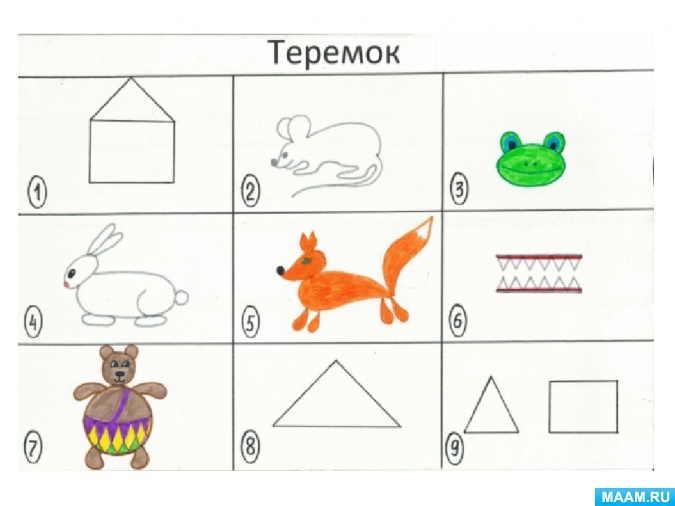
Reading the Russian folk tale "Turnip". (Work according to the scheme)
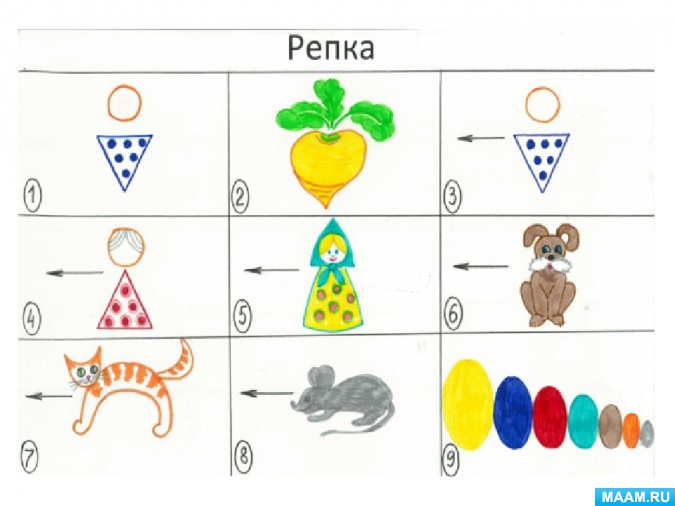
Reading the Russian folk tale "Gingerbread Man". (work according to the scheme)
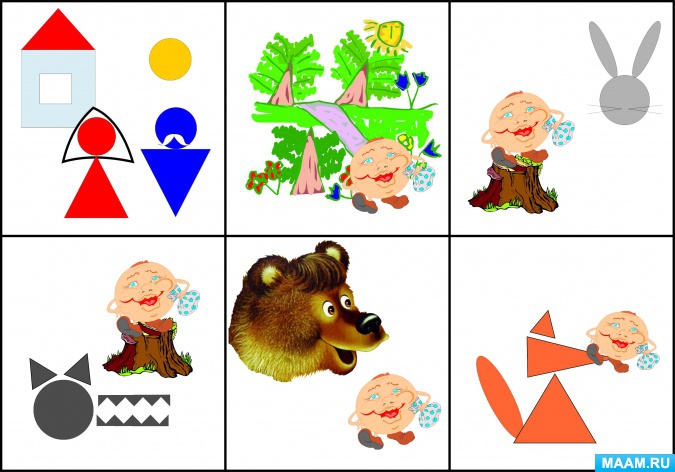
Reading the Russian folk tale "Masha and the Bear." (work according to the scheme)
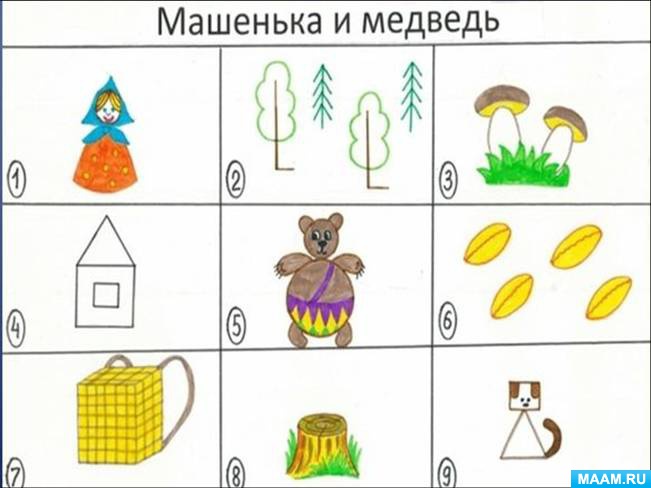
Reading the Russian folk tale "Zayushkina's hut." (Work according to the scheme)

Reading the Russian folk tale "The Cockerel and the Bean Seed" (work according to the scheme)
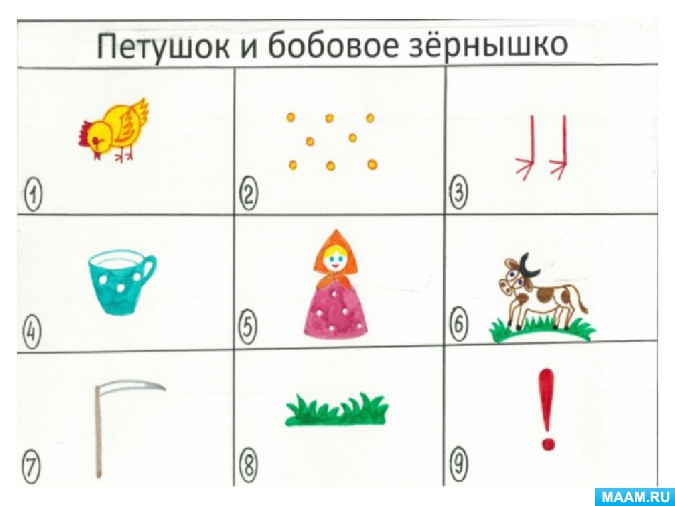
Reading the Russian folk tale "The Wolf and the Goats." (Work according to the scheme)
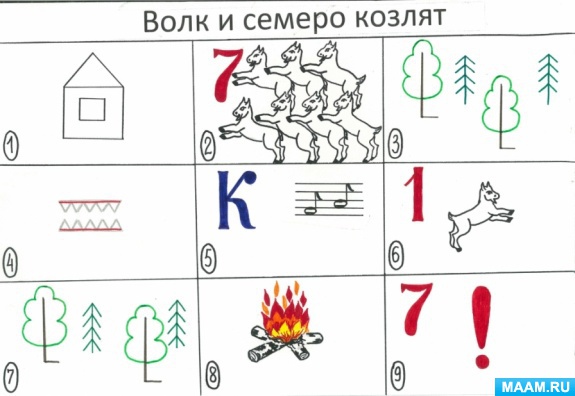
Working with parents
1. Parent meeting: The development of children's speech in the fifth year of life: "Mnemonics for preschool children" - November.
2. Consultation for parents "How to teach a child to describe what he sees?" - December.
3. Moveable folders "What is mnemonics?", "Mnemonics for middle preschool children" - December.
4. Workshop "How to work with mimic tables" - January.
5. Folder shift "Compiling and using mimic tables at home" - February.
6. Consultation for parents "We develop and enrich the vocabulary of children" - March.
7. Making drawings for the exhibition with parents: “Oh, these fairy tales!” - May.
8. Involving parents in making costumes for the presentation of the fairy tale - June.
9. Results of the work on the project: presentation of the fairy tale "The Wolf and the Seven Kids" - July.
The final stage: July 2018
Analysis of the results of the project, conclusions and additions to the project.
Solving riddles from fairy tales.
Didactic game "Our fairy tales".
Let's remember the collage story.
Staging fairy tales by children using mnemonic tables.
Presentation of the results of the project: Show the dramatization of the fairy tale "The Wolf and the Seven Kids" to children of other groups and parents.
Monitoring children for speech development.
Drawing up a plan for expanding the project on the use of mnemonics techniques in working with children in the older group.
Conclusion:
Having done this work, we can conclude that the implementation of the developed methodology of mnemonics in practical work with children of primary preschool age leads to positive changes in the speech and general mental development of children. Children develop a high culture of speech, increase the accuracy, coherence and expressiveness of speech. The child begins to appropriately use the means of artistic expression in his own speech. At the same time, the clarification of the means of forming and expressing thoughts becomes an important stimulus for the development of higher speech forms of his thinking. Replacing text with symbols is an effective means of developing children's creative abilities, the ability to generalize the information received, to speak coherently and figuratively. Mnemonics develops not only coherent speech, but also contributes to the psychological emancipation of the child, eliminates the fear of speaking, develops courage and self-confidence.
In the future, I plan to continue using the techniques of mnemonics in the development of coherent speech, while expanding their range with my own developments.



